 |
Freeman Hrabowski III |
Diversity is focus of Year Three
The SEEC project team is making more connections to increase diversity among engineering students. SEEC team members attended the Iowa State Engineering Diversity Fair, where they learned some successful strategies for recruiting and retaining women and underrepresented minorities from keynote speaker Freeman A. Hrabowski III, president of the University of Maryland, Baltimore County. The SEEC project was also represented at the poster session, where team members exchanged ideas and information with other diversity-focused groups on campus.
 |
Attendees at the joint workshop |
Iowa State's Program for Women in Science and Engineering (PWSE) Role Model Program sends undergraduate students into K'12 classrooms to make presentations about STEM careers and reaches thousands of students each year. This fall two female engineering role models traveled to DMACC to visit their EGR 100 class and answer students' questions about engineering. The presentation was followed by lunch with the role models and several Iowa State staff members. Five female DMACC engineering students attended the lunch and came away with new connections at Iowa State. Through SEEC PWSE plans to increase the number of visits connecting Iowa State undergraduate women with community college students. We hope that these connections and an increased awareness of the resources available to students through PWSE will help our community college female STEM students make a successful transfer to Iowa State down the road.
E:TEC program continues to grow
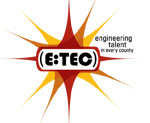 Personal Engineering Resource Kits (PERKits) were distributed to 135 Extension specialists at a statewide meeting in October. These kits provide influential individuals with materials about engineering in general and engineering at Iowa State specifically. Not only are the kits resources for those who seek to provide information about engineering to students, but they are used to train the influencers in how to hold conversations about all that engineering has to offer.
Personal Engineering Resource Kits (PERKits) were distributed to 135 Extension specialists at a statewide meeting in October. These kits provide influential individuals with materials about engineering in general and engineering at Iowa State specifically. Not only are the kits resources for those who seek to provide information about engineering to students, but they are used to train the influencers in how to hold conversations about all that engineering has to offer.
And the training has begun! A second E:TEC Summit was held in November via Adobe Connects. County Extension staff from 40 sites across the state attended—up from 17 sites at the previous Connect. The PERKits were used to show the attendees the resources available to those seeking information about engineering. PERKit training was also provided for 30 adults involved with the Road Less Traveled program. The SEEC project’s DMACC partners have also been introduced to the kits. Feedback thus far has been positive, with requests for more kits and interest in campus visits already being generated. Additional training is planned for 2010 .
Coming Soon!
The E:TEC program will be adding a unique feature to its resource repertoire. The interactive, GIS-based tool is called EPIC (Engineering Possibilities in Every County). With a move of the mouse over a county map of Iowa, one will be able to locate information about engineers and the work they're doing right in their area. The behind-the-scenes database will include information about engineers and their companies—plus a plethora of outreach and education opportunities to learn more about engineering. Often educators, advisers, and other influential parties are unaware of where or to whom they can turn for information about engineering. This map will show them where to find local engineering talent'in every county! Jay Staker, Holly Bignall, and Monica Bruning will be promoting the EPIC program beginning in January.
New recruitment materials developed
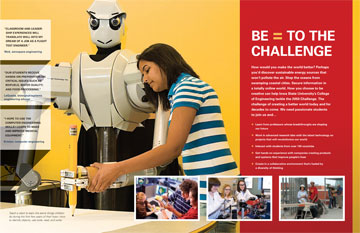 |
|
Spread from the new recruitment brochure |
In keeping with the NSF's recommendations for changing the conversation about engineering, a new recruitment brochure has been created. Its message reflects how engineers can affect positive change in the world. Research has shown this type of message increases interest in engineering among females. However, it is also appealing to underrepresented minorities and general student populations and will help the SEEC project broaden participation and reach its recruitment goals.
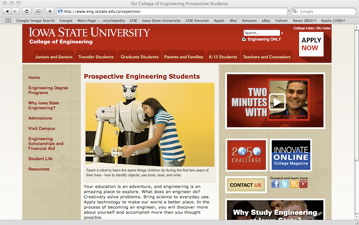 |
Screen shot of new Prospective Students home page |
The College of Engineering's web site for prospective students has also undergone revisions. The look of the site is consistent with that of the new brochure, and the navigation has been streamlined to make it easier for prospective students and others to learn about Iowa State engineering. Tabs for K'12 and teachers and counselors have been added, and links in these sections will help those who work with elementary through high school students find information about engineering in general as well as about engineering at Iowa State.
E-APP is connecting students across the state
Over 120 community college students from across Iowa have joined the Engineering Admission’s Partnership Program’s (E-APP) since the fall of 2007. Each of these students has been assigned an Iowa State adviser and is encouraged to develop an individual transfer plan. These students are also invited to participate in a professional networking site for community college transfer students. Currently 71 community college students are participating in this electronic professional network which provides an opportunity for transfer students to get to know one another as well as meet Iowa State transfer peer mentors, faculty, and staff. Iowa State transfer peer mentors have been hired to help answer questions, post engineering content, and manage the EAPP events calendar. Iowa State engineering faculty and staff are also present on the site. Providing transfer students with an electronic professional network complements the E-APP program by offering a support system and an opportunity to make professional connections with Iowa State’s College of Engineering .
Partnerships make it possible
The SEEC project team hosted an engineering recruitment and retention STEP workshop at the ASEE annual conference and exposition in Austin, Texas, in June 2009. The workshop attracted many attendees from around the country. Mary Darrow, Monica Bruning, Mary Goodwin, Mack Shelley, and Jackie Baughman spoke about the use of logic models in planning, the importance of partnerships, and the various communication pieces developed specifically for Years One and Two of the SEEC project. Randa Shehab from the University of Oklahoma, Kristi Shyrock from Texas A & M, and David Jones from the University of Nebraska at Lincoln also shared their STEP project experiences.
The workshop allowed plenty of time for networking among attendees. Big 12 leaders led small group discussions with participants.'The focus was on providing more in-depth discussion related to the presentations and allowed participants to share and discuss approaches to research and practice related to engineering/STEM recruitment and retention. Big 12 STEP grantees held a meeting after the workshop to discuss items of particular interest to this group. The workshop was well attended by both Big 12 members and others interested in best practices for recruiting and retention. An outgrowth of the workshop is a stronger partnership among Big 12 STEP grantees.
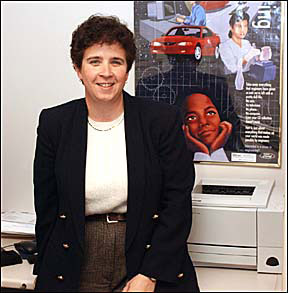 |
Karen Zunkel Director, Undergraduate Support Services, Office of the Executive Vice President and Provost; Director, Program for Women in Science and Engineering |
Connected!
The SEEC project and the Program for Women in Science and Engineering share a common goal of increasing the number of women in engineering. Recently PWSE expanded its outreach program to include community college students. 'Community college students have a wide variety of needs, and we've found it most successful to reach them one on one,' said PWSE director Karen Zunkel. Taking student ambassadors to community colleges to connect with women looking to transfer to Iowa State is just one example of these efforts. PWSE is continuing to develop its relationships with community college faculty and staff who will then recommend PWSE to their female students who are considering transfer to Iowa State. 'We want transfer students to know we're a resource for them as they transition and once they are here,' explained Zunkel. PWSE has also established a learning community for female transfer students. It includes a residential option and provides activities led by peer mentors. 'There has been a lot of collaboration between SEEC and PWSE to look for ways to leverage the role model program to reach out to more women in community colleges,' said Mary Darrow, SEEC executive team member. Zunkel summed up the efforts by saying, 'We're focusing on making the personal connections that will get the community college students to transfer to Iowa State and finish their degree.'
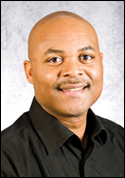 |
Derrick Rollins Assistant Dean for Diversity, College of Engineering; Professor, Department of Chemical and Biological Engineering |
Increasing the number of women and underrepresented minorities in the College of Engineering is a goal shared by Derrick Rollins, assistant dean of diversity and SEEC project collaborator. And both understand the need to change the conversation about engineering, especially when it comes to recruiting and retaining women. 'We need to get students excited about engineering and show them how engineering makes peoples' lives better,' explained Rollins. He takes this message to high school classrooms throughout the region. Each presentation is designed to dovetail with the current classroom curriculum and demonstrate to students how what they are learning can apply to engineering. 'Teachers appreciate this and see our presentations as valuable teaching tools'not just a 'pitch' for Iowa State,' said Rollins. This approach has led to many strong connections between high school educators and Rollins. The presentations have also proven to create quite a 'buzz' about engineering among students, as illustrated in a recent e-mail Rollins received. After presenting to an all-female high school in Nebraska, the physics instructor let Rollins know that students were talking about engineering and asking questions for days afterwards. It is this type of inspiration that will help the SEEC project'and the College of Engineering'reach its diversity goals.


